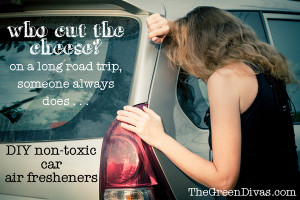Vehicle maintenance doesn’t have to be ridden with toxic chemicals.
I just bought a small, used utility truck. Months of scouring the marketplace and test-driving vehicles reminded me of just how many chemicals most people use in the maintenance and upkeep of their vehicles. I’ve highlighted ten ways to detox your car based on my new book, Weekend Wonder Detox (DaCapo, 2014).
Car Detox
Whether it dangles from your rear view mirror or plugs into your heating and cooling vent, most air fresheners are saturating you in toxic chemicals. This includes the occasional spraying of household air fresheners in your car as well. Find out more about these nasty products in my article “What’s in that car air freshener?” There are companies that make car aromatherapy devices that allow you to use pure essential oils in your vehicles, giving you great scents and health benefits at the same time. Also see: Who Cut the Cheese? DIY Non-Toxic Car Air Fresheners.
Don’t Sweat the Details.
Detailing, the comprehensive cleaning, polishing and waxing of your car’s interior and exterior, involves a host of chemical products and chemical fragrances. Save your money and your health by purchasing a portable steam cleaner at a fraction of the price of a detailing package. I bought one for seventy dollars and use it with a biodegradable, natural liquid soap or a cap full of orange oil in hot water to deep clean my car whenever I want.
Some detailing packages offer engine shampoos as well. If you think you are safe by keeping the chemicals under the hood and out of the car, think again. Those shampoo chemicals will blow in through the vents and you will suck them in with every breath you take. Engine shampoos can contain glycol ether EB (an experimental animal carcinogen), sodium metasilicate, nonylphenol ethoxylated (recongnized as an endocrine disruptor) and sodium xylenesulphonate.
Try this non-toxic, no streak DIY glass cleaner!
Dust Your Dash.
That film of dust that covers your dashboard, console, and gauges is an accumulation of dirt, pollens, dead skin and hair. A regular wipe with a wet cloth will keep the dust to a minimum, reduce allergens and provide relief to asthma-sufferers. The last thing you need is an asthma attack on the freeway.
Now that you have taken care of the hard surfaces above, don’t forget to clean the fabric surfaces as well. There are small vacuums made for cars that will pick up debris and give the illusion of clean. However the motors vent into the car, spewing smaller particles back into the vehicle air space. I prefer an external shop vacuum with strong suction that allows me to keep the motor outside of the vehicle.
Pets Bring Their Own Hitchhikers.
Pet owners are passionate about their furry family members and like to bring them everywhere. Unfortunately, fleas are passionate about dogs, cats and other animals and come along for the ride. Fleas are not just a nuisance. These parasitic insects can cause rashes, allergic reactions and spread disease. They can survive for weeks without feeding so just because Rover isn’t in the car doesn’t mean you aren’t at risk. Break out the vacuum regularly, steam clean the upholstery or take out the seat covers and wash them after your pet is out of the car. Pets also leave traces of fecal matter and urine in your vehicle… enough said.
Vinegar for Visibility.
Forget commercial glass cleaners, water and white vinegar works just as well and costs a fraction of the price. The vinegar’s odor dissipates quickly and is a great replacement for the many toxic chemicals found in commercial window cleaners.
Remove the Food.
Is your car littered with fast food wrapper and half-used ketchup packets? Eventually remnants of your meal on wheels will begin to decompose or grow mold, which can cause allergies and create mycotoxins, including cancer-causing aflatoxins. Mold is not scared off by salt and sugar found in the packets either. It also prefers the warmer temperatures found in most vehicles during the spring and summer months too.
Moisture = Mold.
Speaking of mold, cars are neither airtight nor water tight; rain water, melted snow and spilled drinks can create moisture buildup in your car. If you aren’t aware of moisture leaks at first, you will be when the musky, dank smell builds up when you open the car door. By this point, you may also be experiencing increased allergies, respiratory problems or migraines when driving. Clean up and dry out spills (try a blow dryer to speed up the drying process), repair leaky spots and find a dry, low-humidity spot to open your vehicle up and dry it out.
Get Upwind of Gas Fumes.
Gas stations are hard to avoid for most drivers. Consequently, gas fumes are hard to avoid. Gasoline is extremely toxic and breathing the vapors can affect your central nervous system and brain, respiratory system and cause dizziness and nausea. If you use self-serve stations, try to stay upwind of the pump you are using and don’t squeeze off those extra few clicks at the end of filling up. That’s when most of the fumes escape into your breathing space. If you are at a full service station, keep your window up until you pull away and then roll it down to get an air exchange when you have some space on the road from other vehicles.
Small Space, Big Pollution.
Remember, your vehicle is a small space with questionable ventilation when the windows are closed. Chemicals, fumes, scents, including personal care products like perfume, hairspray and fabric softeners, will not dissipate quickly in such a small space, creating a highly polluted environment. The same poor air quality exists in garages that typically house chemicals such as solvents, paints and other toxic products. If your car has been parked in the garage all night, you are inhaling all these substances when you leave for work the next morning. Open the garage door before you leave to air it out and drive that first mile with the windows down to get the stale air out and fresh air circulating.
Written by Michelle Schoffro Cook for our friends at Care2.
Bonus:
Listen to this great first Green Divas at Home podcast! Beth Greer, author of Supernatural Home, talked to us about a few common things found in our homes that could be aging us prematurely — yikes! Read Beth’s excellent post, too.


Laurel Standley
May 19, 2014 at 6:16 pm
Thanks for the wonderful post Michelle! This is an important environment rarely covered. I’d add one more suggestion – after you pull the car in, let the exhaust clear from the garage if it’s attached to the house.
Green Diva Meg
May 19, 2014 at 6:53 pm
fantastic post. thanks Michelle!